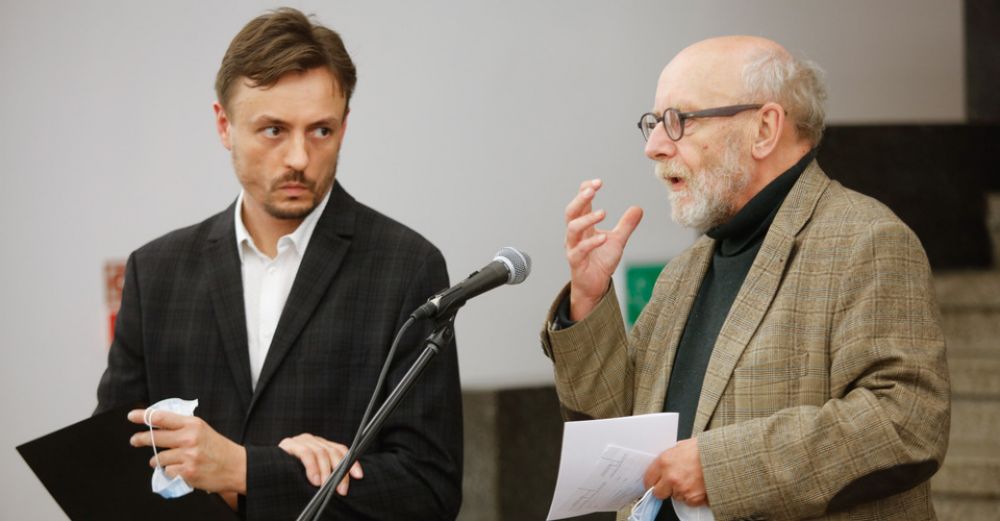- News
- Events
- Oneg Shabbat
- Collections
- Research
- Exhibitions
- Education
- Publishing Department
- Genealogy
- About the Institute
- Bookstore


– The hardest thing was to find the letters, works of art, drawings and paintings by Trachter. It is of great value that a catalog of the exhibition has been published, which is something more than a catalog, it is a story about Trachter himself, and we know very little about him: only that his previous exhibition took place in 1930, 90 years ago. At the present exhibition, we recall a painter who in fact does not exist in the cultural consciousness of Poland – said professor Paweł Śpiewak, director of the Jewish Historical Institute.
– My adventure with this painter begins at the Józef Czechowicz Literary Museum in Lublin – added professor Śpiewak. – I used to go up the stairs where paintings usually hung. Suddenly, I saw a painting that hangs in our exhibition, an image of a dancing Lublin. When I saw this painting, I thought: this is some painter. Then I found out it was Simon Trachter. When I went out into the city, I had a feeling that it was possible to look at the houses through the eyes of Trachter, look at this Lublin a bit shaky, a bit dancing, a bit restless: a serene image of Lublin, in fact very gentle, it is not a catastrophic image. We must remember that in Lublin, the entire Jewish district and the synagogue were destroyed, and the Jewish traces were very tarnished. Once I found a few gates with mezuzahs and persuaded the director of the NN Theater to take them to the museum. Now they are gone, they have been destroyed.
– It was actually the first generation of Jewish painters who started exhibiting, revealing the works of artists of Jewish origin in Poland. 99 percent of these painters were murdered. There is no continuity, it has been broken and it cannot be reversed.
– We aimed to reconstruct the life of Trachter, about whom many things we did not know, and to show the artist’s entire output that has survived, 41 paintings and drawings in total – said the exhibition’s curator, Jakub Bendkowski. – Most of these works belong to the Lublin Museum, some are in the Vistula Museum in Kazimierz Dolny, eight in the Jewish Historical Institute. We show them in chronological and topographic order, following the places which were most important to Trachter: first and foremost Lublin and Kazimierz Dolny, and then Paris, where Trachter studied for four years, watched his colleagues, visited the Louvre; there happened a breakthrough in his oeuvre, his style changed radically. Experiments with texture, with the application of paint, gave very interesting results. The background for Trachter’s life and work is the life of his colleague, the would-be painter Wiktor Ziółkowski, thanks to whom his work survived.
The exhibition is complemented with photos taken by Ziółkowski, showing the corners of Lublin, Kazimierz and Trachter himself. Agnieszka Mastalerz’s work – a projection of a dozen double echograms – evokes Trachter’s last painting: the unpreserved Job, co-created with other painters, which appeared on the inner walls of the building of the Jewish Community in the Warsaw Ghetto in 1942.
– I had most of these works in my hand. It is amazing to perceive Trachter’s art, because he did not always paint on canvas. Very often it is plywood or cardboard instead: simply random materials that he had ad hand when he had to paint. I also appreciate Symcha for the drawing technique, in particular the use of sanguine – said Jolanta Żuk-Orysiak, deputy director of the Lublin Museum.
Visit the temporary exhibition Symcha Trachter 1894–1942. Light and color until October 25. Details at this link.
![tr_sign_1.jpg [419.65 KB]](https://www.jhi.pl/storage/image/core_files/2021/4/21/4bfe1fb37885f316a69c23453e45f451/jpg/jhi/preview/tr_sign_1.jpg)
The objects presented at the exhibition were lent by: The Lublin Museum, Lublin, The Hieronim Łopaciński Provincial Public Library in Lublin and The Vistula Museum in Kazimierz Dolny
The exhibition is financed by Iceland, Liechtenstein and Norway from the EEA Grants and the Ministry of Culture and National Heritage of the Republic of Poland
![EOG_norw_belka_PL.png [47.79 KB]](https://www.jhi.pl/storage/image/core_files/2020/10/8/4b7d11f51b5cf87bd19aab5d83dc87df/png/jhi/preview/EOG_norw_belka_PL.png)